Daizen Maeda (173cm/5’8”, 68kg/150lbs) is currently the top scorer in one of the most successful football divisions in Asia — Japan’s J1 League, where he plays primarily as a right-footed left-winger but occasionally as a centre-forward for second-placed Yokohama F. Marinos under former EPL and EFL Championship centre-back, Kevin Muscat. Maeda’s manager, who developed a notorious reputation during his playing career, also played in the Scottish Premiership for Rangers but despite Muscat’s Ibrox-affiliation, 24-year-old Maeda has been linked to the other side of Glasgow in recent weeks, with Celtic manager Ange Postecoglou said to be keen on reuniting with the Japanese attacker who was initially signed by Marinos during Postecoglou’s spell as their manager.
Postecoglou recently confirmed that Japan is “one of the markets [Celtic] will be looking at” in January when the Scottish transfer window reopens and the J1 League season comes to a close, while Maeda, currently valued at £990k according to Transfermarkt, is one name that’s heavily touted as being on the Australian coach’s wishlist.
So, what is it about Maeda that’s got Postecoglou so keen to return for his former player? In this tactical analysis and scout report, I’ll attempt to answer that question by providing some in-depth analysis of Maeda’s game. I’ll analyse the Japan international’s role within Marinos’ tactics, highlight the key strengths of his game (including analysis of why and how he’s scored so many goals this season), as well as provide analysis of some notable areas of improvement in Maeda’s game to share a more complete picture of who the player Celtic want is, and who he isn’t.
Attacking movement
Following intense reports linking Maeda with a move to Parkhead, former Arsenal striker Kevin Campbell recently urged the Hoops to move for the Japanese forward, stating: “If you can bring a goalscorer in, it will take the burden off the other strikers. Someone who can put the ball in the back of the net is worth their weight in gold. I am not surprised Celtic are interested in him. His record speaks for itself” (via Football Insider).
The impressive record Campbell referred to is Maeda’s 17 goals in 2623 minutes of J1 League action this term. These 17 goals have come from an average of 2.33 shots per 90 (high but not abnormally relative to other strikers and wingers in Japan’s top-flight this season). Maeda has also managed to maintain a 55.88% shot accuracy rate this term, which ranks very well when compared to other J1 League attackers (strikers and wingers) this season. So, we can see that although the Marinos forward has been taking plenty of shots this season, he’s not been wasteful and has generally been hitting the target fairly reliably.
As well as being J1 League’s top scorer, Maeda has generated the highest xG (14.89) of any J1 League player this season from his goalscoring opportunities. This is a good indicator that Maeda’s high scoring rate is fairly well deserved due to the high-quality chances he’s had. Part of the credit for this should go to Maeda’s teammates for consistently creating high-quality goalscoring chances for him. His team have capitalised on the abilities he brings to the table and made him a key part of a functional attacking system that rewards his greatest attacking qualities. Part of the credit for this should also go to Maeda himself, for performing his role and utilising his best qualities well within this system and consistently getting himself into good goalscoring positions from where he’s getting shots off and ultimately scoring goals.
Maeda’s off-the-ball attacking movement is a key part of his game that allows him to find space in very high-value positions inside the penalty box. His teammates know the movements he likes to make to free himself up in threatening positions, while Maeda’s also good at timing and adjusting his movements to the work of his teammates on the ball to ensure that he’ll be best placed to get on the receiving end of a pass when his teammate wants to play it. This high level of understanding between Maeda and his teammates has, of course, played a key role in his success in front of goal this term. In this section of analysis, however, we’re going to mainly focus on how Maeda moves off the ball during attacking phases to highlight exactly what the attacker is doing to consistently free himself up in very dangerous positions.
The Marinos man is extremely quick and uses his pace a lot during games. He is also very agile, using this agility while moving off the ball to quickly change direction at pace, and he tends to time his movements very well, both in terms of reacting to his teammates’ movement around him and on the ball as well as making himself more difficult for opposition defenders to keep track of.
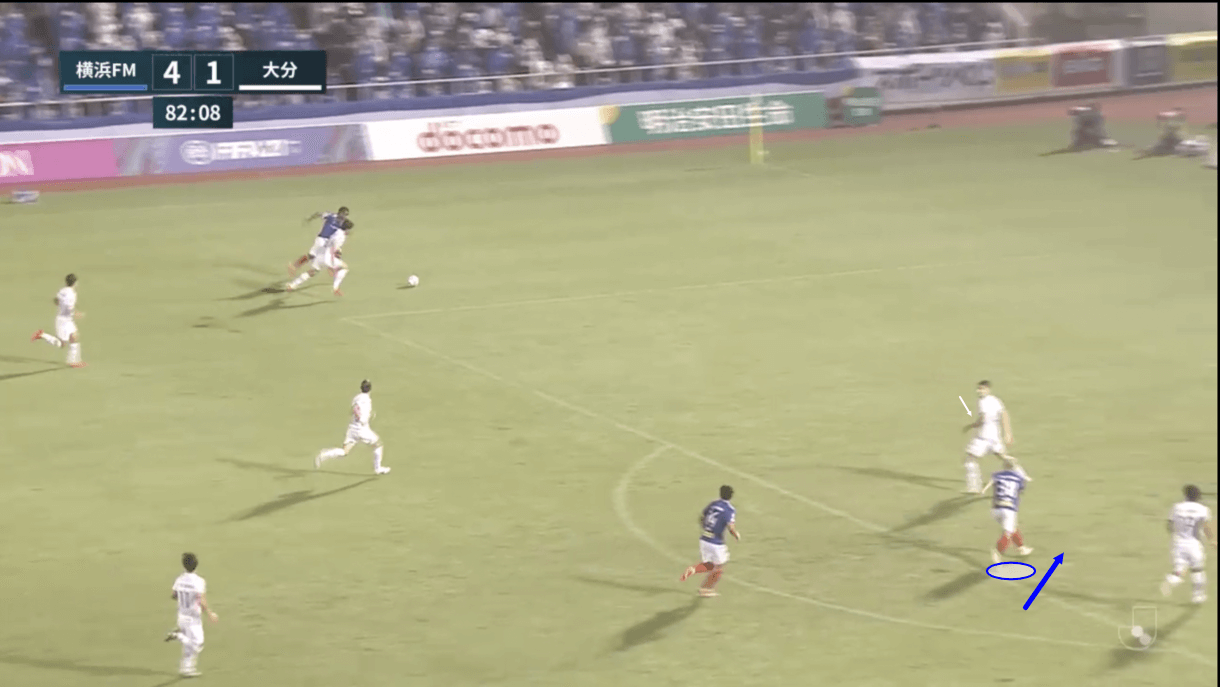
Figures 1 through 3 provide our first in-game example of Maeda’s off-the-ball movement in attack. Starting with figure 1, we see the attacker — occupying the centre-forward position at this moment — making a run into the penalty box between two opposition centre-backs while his teammate on the left-wing attempts to beat the opposition’s right-back 1v1 to progress into a crossing position.
Here, Maeda enters the box with no opposition defender particularly tight to him. As movement happens around him, Maeda remains patient and this patience is then rewarded with the attacker ultimately ending up in more space than he otherwise would be, which is the case in figure 1.
As the attack progresses and Maeda’s teammate on the wing starts to take the ball past the opposition full-back, we then see the attacker spring into action and start accelerating into the box. Maeda is extremely quick at reaching a high speed when starting from a standing position. This is another one of his biggest strengths as it makes him more difficult for opposition defenders to mark. Even if defenders are tight to him, they can find Maeda difficult to track because he’ll generally be far quicker than them to reach his top speed, which is also faster than most defenders. On this occasion, Maeda’s quick acceleration helps him to enter the box and remain unmarked, with the opposition defenders failing to react quickly enough to his movement and get tight enough to him as he quickly sprints through a gap in the defence.
At this moment that Maeda starts his sprint forward in figure 1, however, we can see the opposition centre-back in front of him checking his shoulder to try and track Maeda’s run. At this point, Maeda was running towards this centre-back, which could go some way to leading the defender into a false sense of security that his positioning would be good enough to protect the box from the attacker.
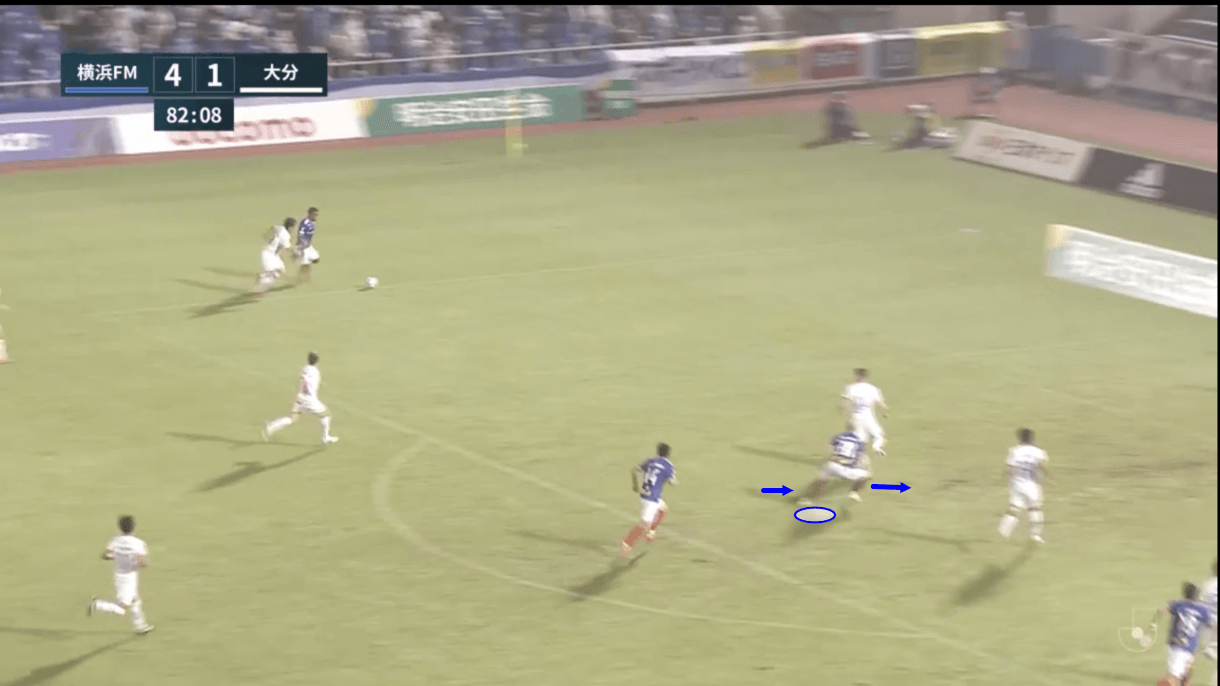
In figure 2, we see that as the centre-back turned his attention back to the man on the ball, Maeda quickly and intelligently planted his left foot far ahead of his body and used this planted foot as leverage to bounce away into a different direction. Maeda’s agility is on display here, as he managed to quickly change course from moving towards the centre-back in front of him to moving sideways, towards the opposition’s goal.
As mentioned already, the opposition centre-back’s attention has turned back to the man on the ball at this point, meaning that he’s not able to keep track of Maeda’s movement while the Marinos man changes direction. This intelligent timing of his change in direction not only keeps Maeda in the very centre of the box but also helps him to get out of the defender’s cover shadow, making him an easier target for his teammate.
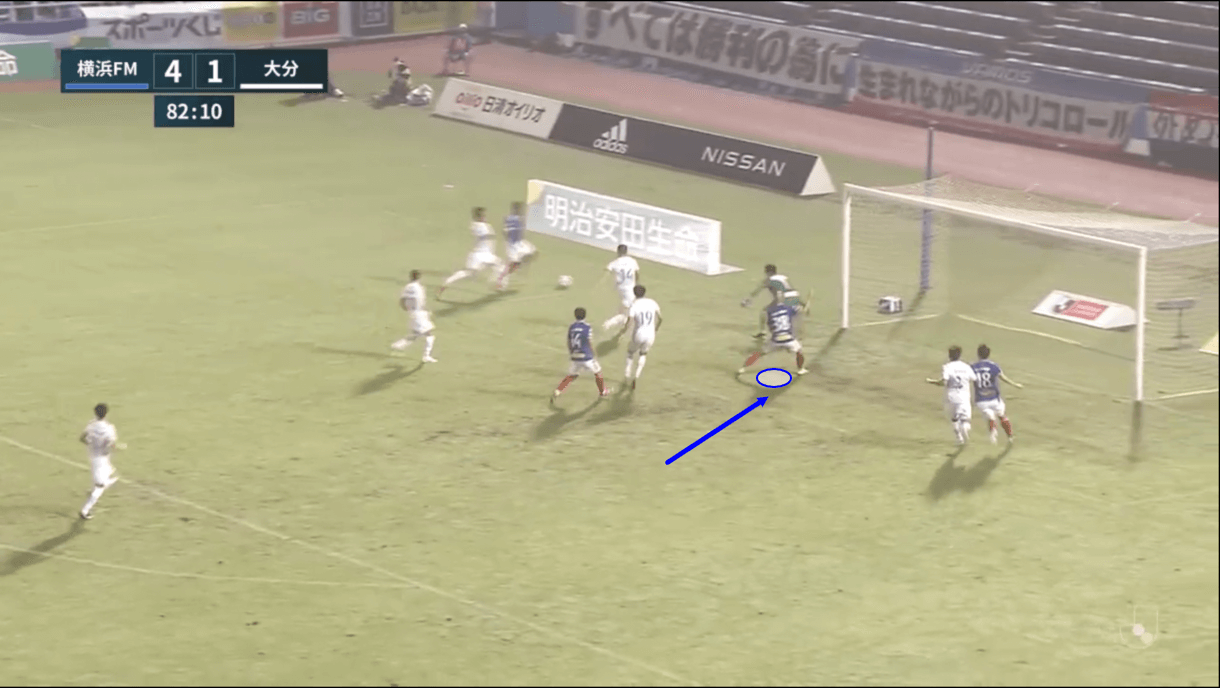
As play moves on into figure 3, we see that Maeda ultimately ended up drifting into the six-yard box unmarked and in an excellent position to get onto the end of either a low drilled cross in front of the goalkeeper or a lightly chipped lob over the ‘keeper. The Marinos man in possession opted for the latter on this occasion and as play moves on from here, we see Maeda take a big step back before finishing mercilessly with his head into an open net. This passage of play highlights the benefits of Maeda’s pace, acceleration, and intelligent observation of the opposition defenders, along with his teammates.
This also highlights the fact that Maeda can finish with his head, which he has done successfully on five occasions this term in the league — the joint-most of any J1 League attacker. Despite this impressive aerial record, the 173cm attacker isn’t dominant in the air at all. He’s got a bad aerial duel success rate (24.64%) this season, from a relatively low number of aerial duels contested (2.37 per 90). So, this positive headed goal record isn’t to say that he should be seen as a significant aerial threat.
However, Maeda’s off-the-ball movement helps to create headed goalscoring opportunities like this one from figure 3 regularly as he’s consistently able to free himself up in very dangerous positions as we see here from where he can finish with his head uncontested. While Maeda doesn’t typically perform great in aerial duels, he’s more than capable of finishing uncontested aerial balls and he’s good at creating those opportunities for himself via his off-the-ball movement.
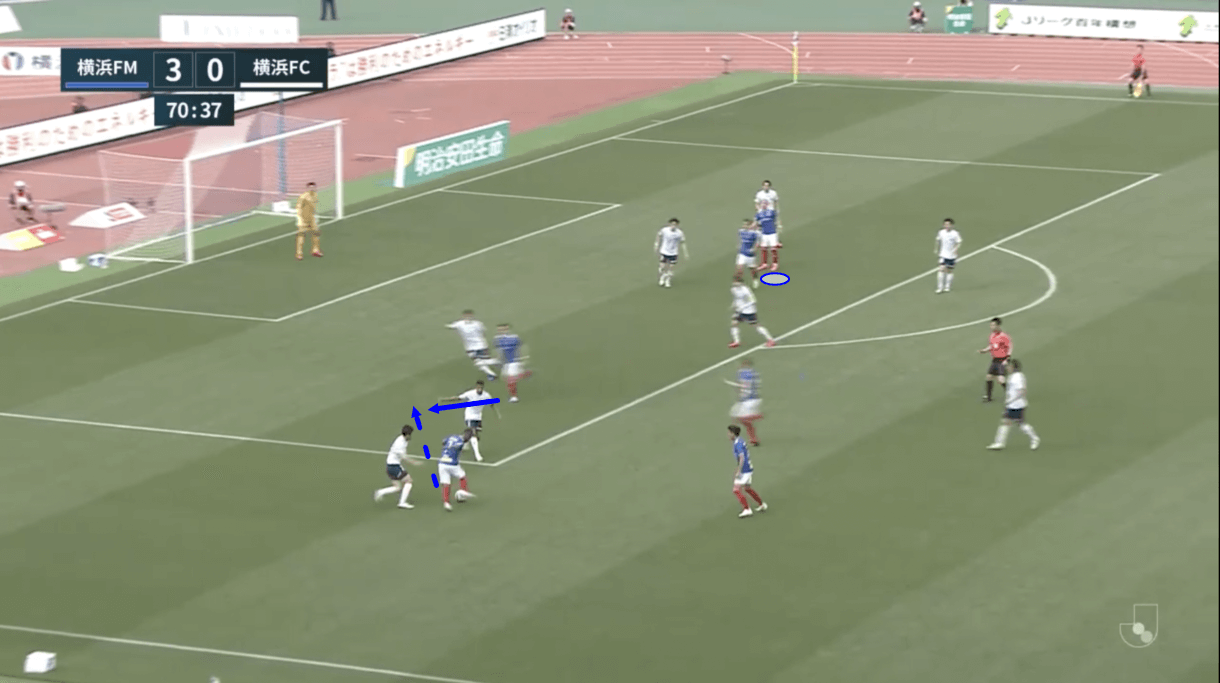
In figures 4 and 5, we see another example of Maeda bursting into action from a standing position and using his impressive acceleration to create space for himself in a very dangerous position. In figure 4, we see Marinos working the ball into a crossing position via some link-up play on the left-wing while Maeda is positioned inside the box between two defenders, with one right behind him.
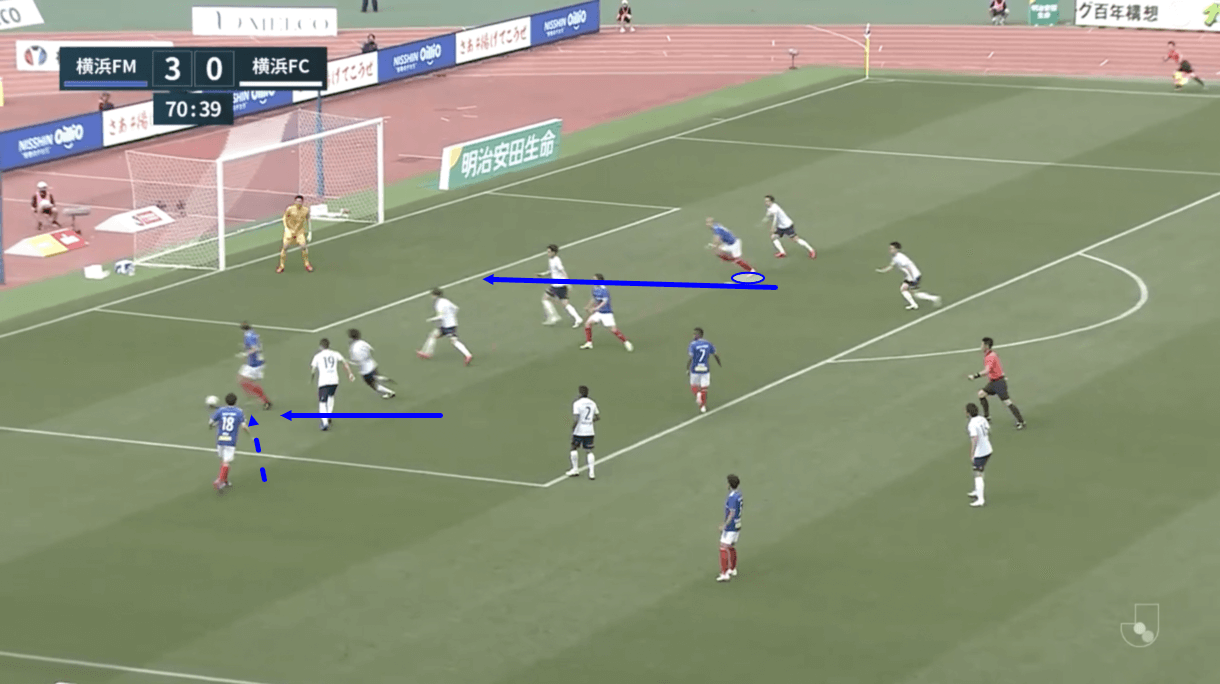
As play moves on into figure 5, we see that Marinos have managed to create the crossing opportunity they’d been working for on the left-wing and Maeda reacts to this by sprinting into space towards the centre of the six-yard box yet again. A teammate drew the centre-back in front of him in figure 4 away via his movement, which left Maeda with space to run into ahead of him. Meanwhile, the defender behind the Marinos man was unable to keep up with the attacker once he opted to burst into action and run into this space. This left Maeda in lots of space as he made his way into the six-yard box and as play moves on from figure 5, we see the attacker finish comfortably from the centre of the six-yard box with his first touch.
This passage of play highlights the benefit of the 24-year-old’s impressive acceleration yet again, as he sped away from the closest defender just behind him without much trouble, allowing him to exploit the space that opened up in front of him to get onto the end of the low driven cross.
Maeda isn’t an attacker who likes to receive the ball to feet, he doesn’t engage in lots of link-up play or participate much in chance creation on the ball, and he doesn’t often look to take the ball past defenders via a dribble. Within the final third, he’s an aggressive, direct attacker who stands out via his off-the-ball movement.
Additionally, Maeda is very accustomed to finishing with one touch, which is what he opted for in both examples we’ve analysed thus far. He’s good at finishing with one-touch aerially by creating space for himself to do that from threatening positions inside the box and he’s also good at finishing with one touch via either foot from these threatening positions. When getting onto the end of low driven crosses in dangerous positions close to goal as we saw in figure 5, it’s common to see Maeda intelligently use the pace and power of the low driven cross to direct it towards goal. He simply gets in position and opens his foot towards goal, allowing the ball to collide with the open foot while he’s moving towards it and subsequently guiding it into the net from the dangerous position. This is one of Maeda’s favourite finishes and we’ve seen him pull it off on several occasions this term. He enjoys the opportunities to pull off this finish often thanks to his effective off-the-ball movement that regularly gets him into high-value positions unmarked.
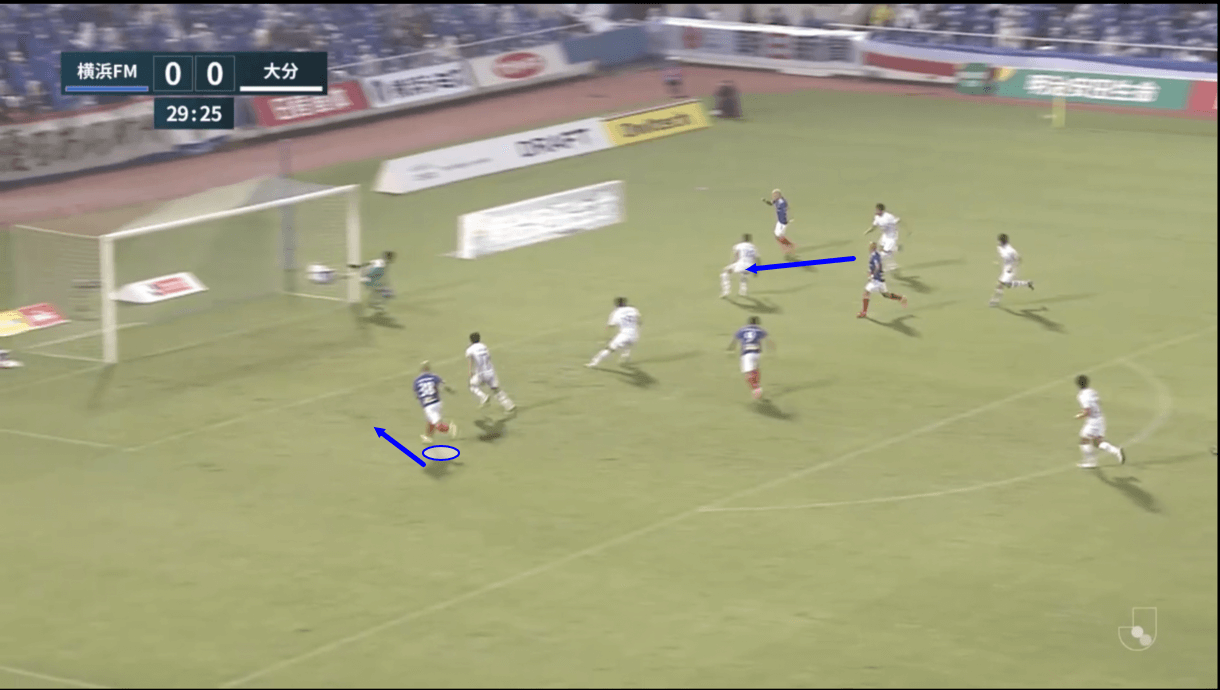
Maeda is good at making runs into the box on the blindside of the defender in front of him. This is particularly evident when the attacker is playing from the left-wing when he’ll generally be positioned behind the opposition’s full-back, as we see in figure 6. Here, with Maeda’s teammate in possession on the right-wing and two other Marinos attackers in the box ahead of him occupying the centre-backs, Maeda makes his run towards the far post behind the opposition’s right-back, who’s the nearest defender to the Japan international here.
It’s intelligent to make the run on the defender’s blindside as it makes Maeda more difficult for that defender to keep track of. This then helps the Marinos man to find space inside the box by making subtle movements that go unnoticed.
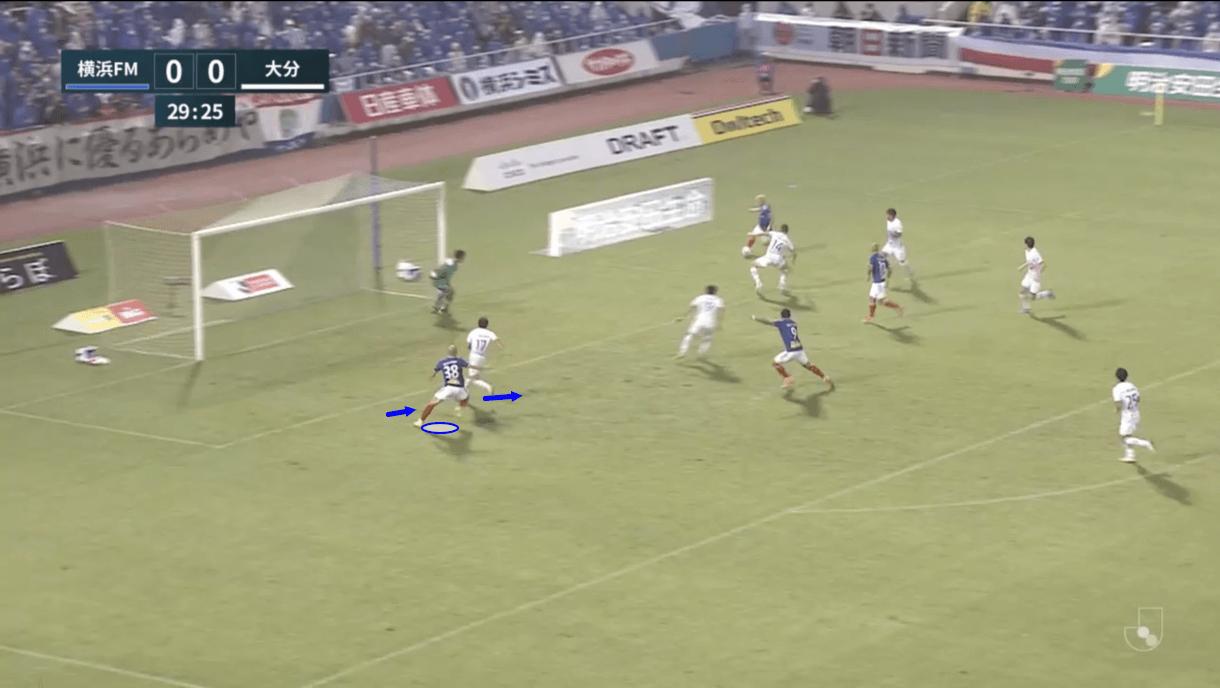
With Marinos progressing further into the penalty area, Maeda decided to make his move and spring out from behind the full-back as the play moves on into figure 7. Again, we see the attacker use his left foot as a launchpad for a change in direction here. He sticks the foot out in front of him in the opposite direction of where he wants to exit, bounces off the foot and begins moving to the other side of the right-back to try and find space in the centre of the box — a high-value area that he typically likes to target and from where he can provide a crossing option for the man in possession.
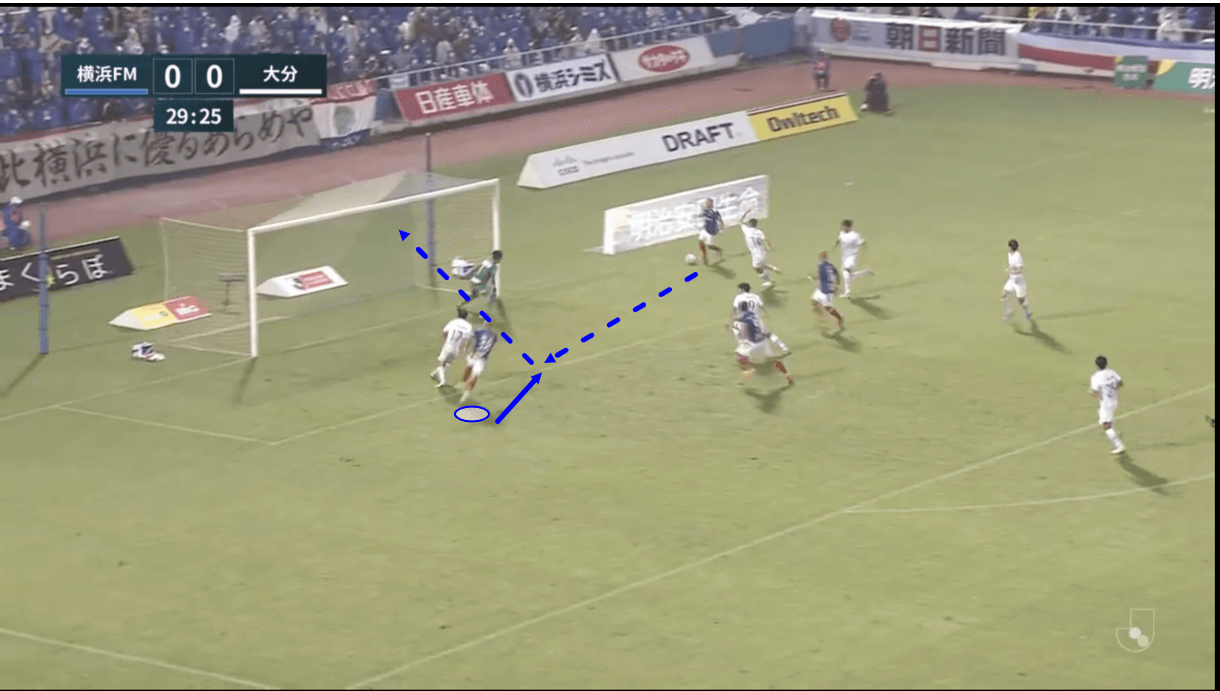
In figure 8, we see how Maeda’s swift change of direction began to pay off as the attacker exited on the inside shoulder of the full-back who was unaware of the forward’s movement. As he progressed into the centre of the six-yard box unmarked, Maeda opened a clear passing lane between him and the right-winger on the ball. As play moves on, we see the right-winger drive the ball low and hard across the six-yard box into Maeda’s path, with the 24-year-old meeting the pacey cross inside the six-yard box and redirecting it towards goal by opening up his body and foot while quickly moving towards the ball.
Again, this passage of play highlights the benefits of Maeda’s acceleration, agility, and intelligent decision-making that aids his attacking off-the-ball movement. These physical and mental traits are key for the 24-year-old goalscorer’s potency in the opposition box. These traits help him to optimise his technical finishing quality.
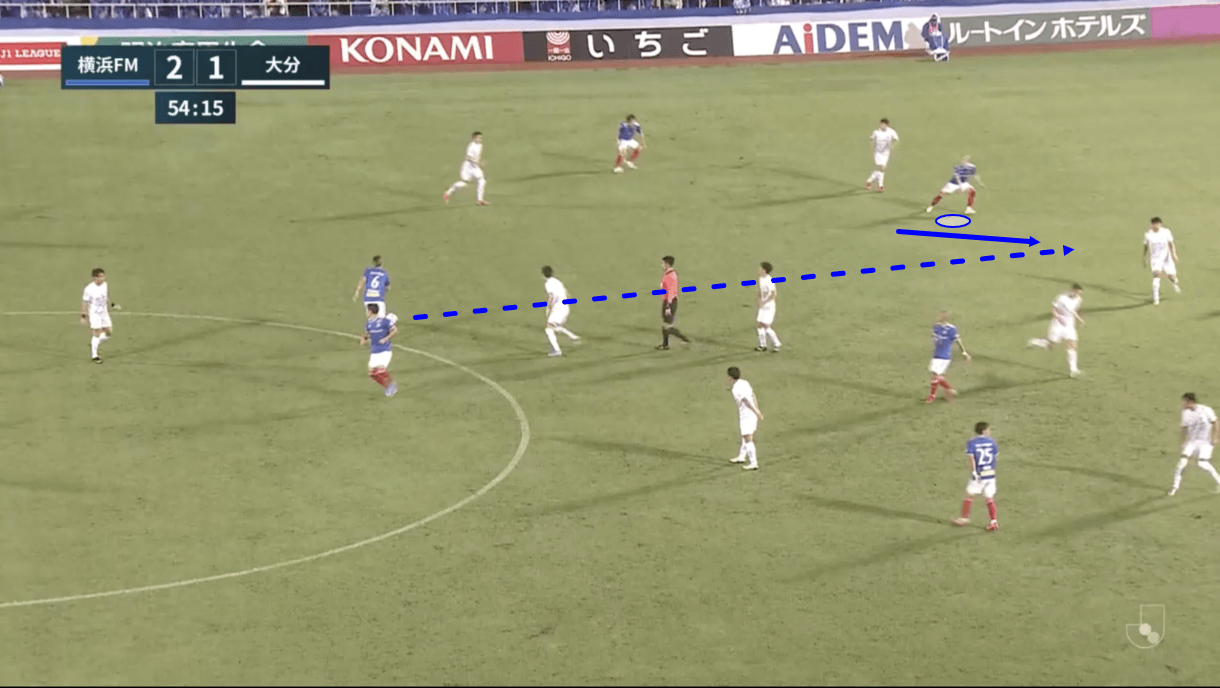
As mentioned earlier, Maeda isn’t a forward that particularly likes to receive the ball to feet. When playing against a slightly higher defensive line than the ones we’ve seen so far in this tactical analysis, like the one we see him playing against in figure 9, this sees him looking to make runs from off the shoulder of the defenders targeting space in behind the backline. His rapid pace and acceleration help him to pose a significant threat to the opposition from these situations. If Maeda is given space to run into, whether that’s to get onto the end of a through ball targeting space behind the defensive line or targeting space opening ahead of him to finish a cross, he’s capable of punishing the defending side through his pace, intelligent movement and good technical finishing quality.
As Maeda is so good at creating these situations, this has played a big part in him successfully generating the highest xG of any J1 League player this term.
Diverse finishing styles
Maeda is a right-footed attacker who primarily plays off the left-wing. He enjoys opportunities to open up his body when running onto the ball from the left side of the opposition’s box and curl the ball towards the far post.
Typically, as mentioned previously, he likes to finish with one touch. Most commonly, this sees Maeda finding space in the centre of the six-yard box, opening up his body and directing a teammate’s low driven cross towards goal. He benefits from free headers created via his off-the-ball movement quite often too. When finishing so close to goal with one touch, Maeda is comfortable using either foot. However, his two-footedness isn’t limited to those situations. The Japan international is comfortable finishing with either foot from slightly more difficult shooting opportunities too, which adds some unpredictability to his game and can make him far more difficult for opposition defenders to deal with.
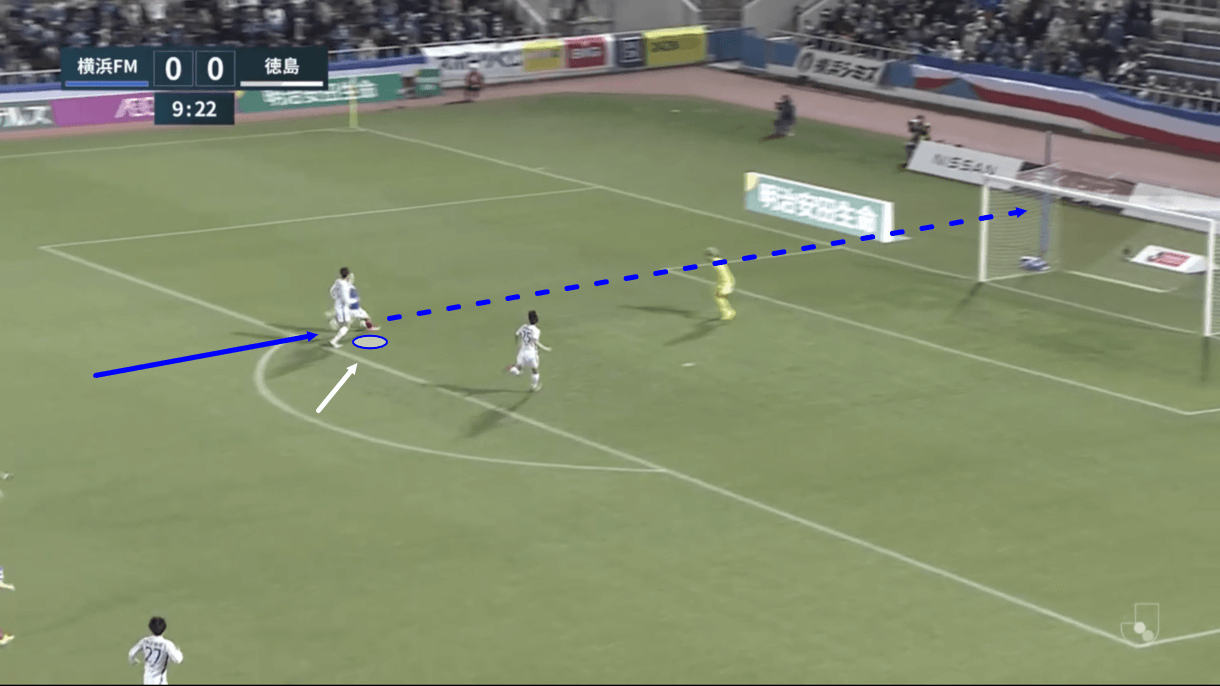
Figure 10 provides an example of one such occasion when Maeda’s two-footedness was vital in helping him and his side to score. Just before this image, the 24-year-old was played in behind the opposition’s backline via a through ball that he got onto the end of without much problems thanks to his well-timed run, along with his pace that helped him to get in front of the defenders.
However, the defenders retained an advantage over Maeda despite all this, as they positioned themselves well to block the attacker from cutting inside onto his stronger right-foot and setting up that curled shot across goal towards the far post.
If the Marinos man were one-footed, this could be a very effective defensive technique because the attacker would either be forced to shoot with a significantly weaker foot, making the resulting shot far less likely to go into the net, or he’d be forced to hold onto the ball for longer, allowing the defending team more time to regroup.
Maeda is strong on his weaker left foot, however, and he was comfortable with shooting on his left foot here. The Marinos man targeted some space at the front post and calmly drilled the ball towards it, beating the goalkeeper and scoring a powerful goal for his side. This highlights the benefit of Maeda’s two-footedness. When combined with his pace and movement, it makes him even more difficult to defend against and can easily result in more goals. The Marinos attacker gives opposition defenders a lot to worry about via his various attacking threats and his two-footedness is one of his greatest strengths in that regard.
Dribbling
Per Wyscout, Maeda has made 3.71 dribbles per 90 this season with a 50.93% success rate. This isn’t a tonne of dribbles nor is it a particularly outstanding success rate but it does rank him above average for both dribble volume and dribble success among J1 League attackers. As mentioned earlier, however, Maeda is an attacker who likes to attack space as opposed to receiving the ball to feet. He likes getting onto the end of through balls and receiving while running into space and as a result, he doesn’t get into many 1v1 duels that see him running at a defender.
Similar to his off-the-ball attacking movement before finishing chances in the box, Maeda’s agility plays an important role in his dribbling. The attacker’s ability to quickly change direction helps him to get past opposition defenders before receiving the ball, setting up an opportunity for the forward to run into space without actually taking the ball past the defender himself through his technical dribbling quality. Maeda generally tends to rely heavily on his physical qualities when aiming to beat defenders either with the ball or when looking to receive the ball.
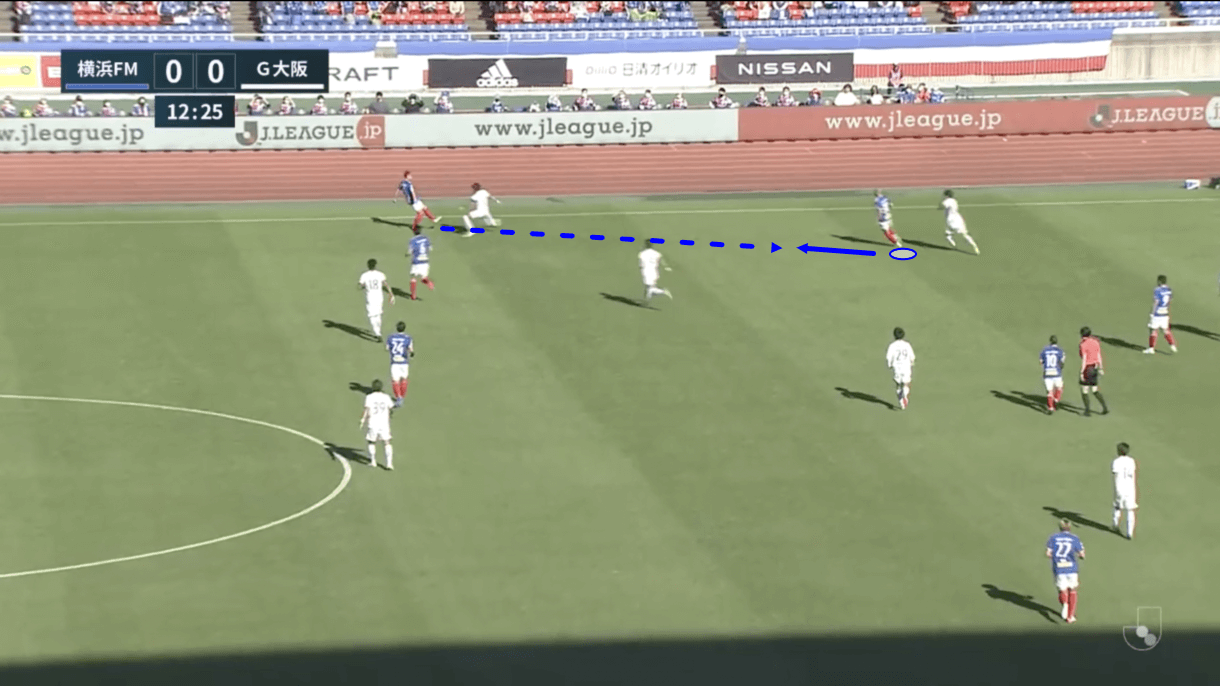
Figures 11-13 show an example of one passage of play that highlights Maeda’s agility and how it helps him to get past opposition defenders when receiving passes to feet as, despite his preference being receiving the ball while running into space, he does sometimes have to settle for dropping off and receiving the ball to feet, as was the case in figure 11. However, Maeda is good at turning these situations into more favourable ones that better suit his style.
In the image above, we see Marinos’ left-back playing a pass down the left wing into Maeda’s feet, with the attacker dropping off from the defender behind him to meet the ball.
It’s worth noting how Maeda’s movement towards the ball here drags the opposition defender out with him, as this defender doesn’t want to allow the attacker to just drop off and receive the ball in lots of space.
However, Maeda is happy to play with a defender tight to him. It’d play to his strengths less if he were to receive the ball in lots of space between the lines either with his back to goal or while facing a settled, organised backline. Maeda wants to be facing towards the opposition’s goal with lots of space to run into so he can unleash the full extent of his pace. So, this image provides an example of Maeda manipulating the opposition defender’s positioning with his movement.
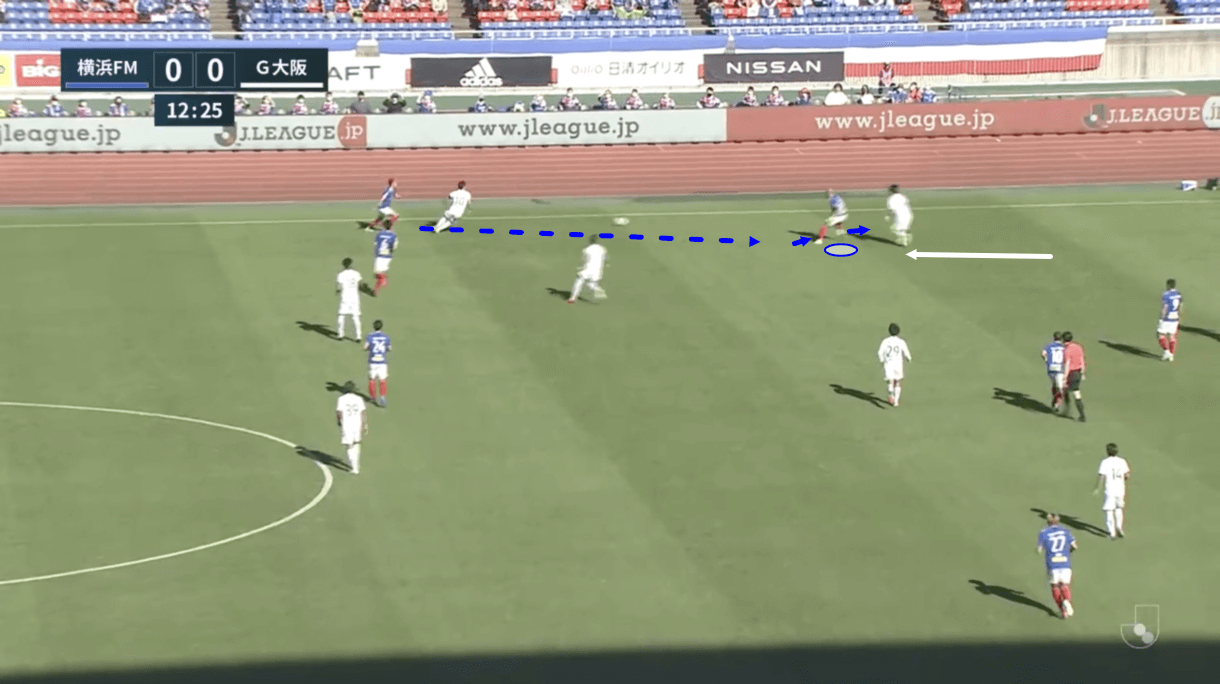
As play moves on into figure 12 and the pass gets closer to reaching Maeda, the attacker plants his left foot out in front of him in the opposite direction of where he intends to burst away and uses it to launch off from as we’ve seen him do on several occasions already in this scout report. The attacker uses this left foot as a platform to launch off of and quickly change direction while exiting in the opposite direction with pace and power. On this occasion, the forward wants to change the direction of his run to target space behind the defender tracking him closely.
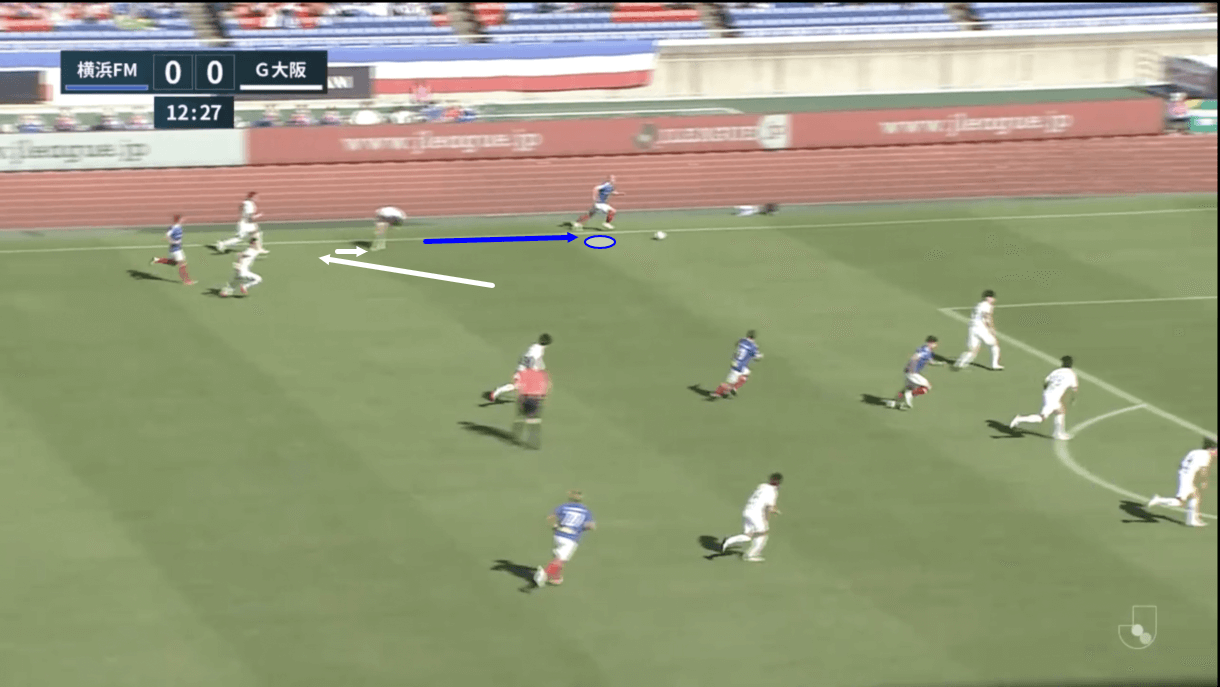
While Maeda is quick, agile, and ultimately capable of changing direction very sharply, the defender tracking him was unable to perform the same movement which results in the scene we see in figure 13. The Marinos man has broken free of his marker and is now running into space on the left-wing as he’d want to be, having gotten onto the end of the pass from the left-back and changed the situation from one of receiving the ball to feet with a defender right behind him into one of receiving a pass into space.
This passage of play highlights another benefit of Maeda’s agility and pace, as well as some intelligent decision-making. The attacker knows his strengths and he’s good at setting up opportunities to use them.
To reiterate an important point from this passage of play, Maeda likes playing with defenders tight to him because his speed, acceleration, agility and intelligent movement can help him to sharply spin away from them as we see here. He’s more effective in this kind of situation where the defender followed him when dropping deep than he would be if the defender just allowed him to drop deep and prepared for a 1v1, as while Maeda’s pace helps him to beat defenders in 1v1 battles, he’s not a tricky dribbler who you’ll expect to see beating men through his technical skill on the ball regularly.
This isn’t to say that Maeda is great when playing with his back to goal — he is not — but he’s good at changing these kinds of situations where he’s initially receiving with his back to goal into situations where he’s receiving while running into space (his preferred situation) through the qualities that we’ve mentioned.
Passing and involvement in chance creation
Maeda has taken a relatively high number of touches in the penalty box (4.77 per 90 — joint-6th among J1 League attackers) this season but outside of the penalty box, he doesn’t generally get very involved on the ball. This sees Maeda make a very low number of passes. He’s a direct and aggressive attacker who doesn’t tend to get very involved in link-up play. His role, typically, is to provide the depth for his team by looking to exploit space behind the backline through his intelligent movement and the threat of his pace.
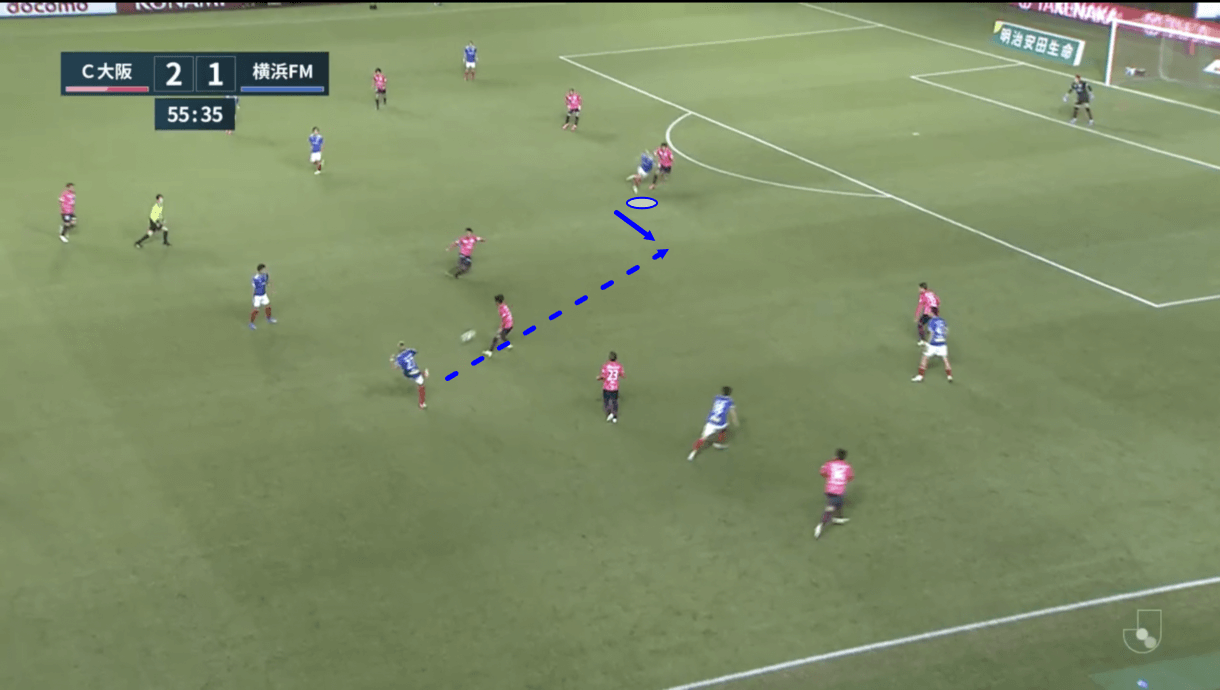
Regardless of whether he’s playing as a centre-forward or a left-winger, there have been plenty of examples showing Maeda’s discomfort with receiving with his back to goal this term. These instances, like the one shown in figure 14 above, highlight his unsuitability for receiving with his back to goal and hammer home the point that he’s an attacker whose main role in chance creation should be in his off-the-ball movement as opposed to on-the-ball involvement. Here in figure 14, we see a Marinos midfielder directing a pass into Maeda’s feet, while the 24-year-old runs into some space on the right side of the box to receive the pass.
Even when playing with his back to goal, Maeda always wants to run onto the ball to receive it. He’s not very physically imposing or strong, so wouldn’t succeed when backing into defenders and instead, he opts to try and attack space, which he’s more comfortable with. However, the big difference between a situation like the one we see here in figure 14 and the previous examples of Maeda attacking space is that the attacker has a defender blocking his path towards goal here.
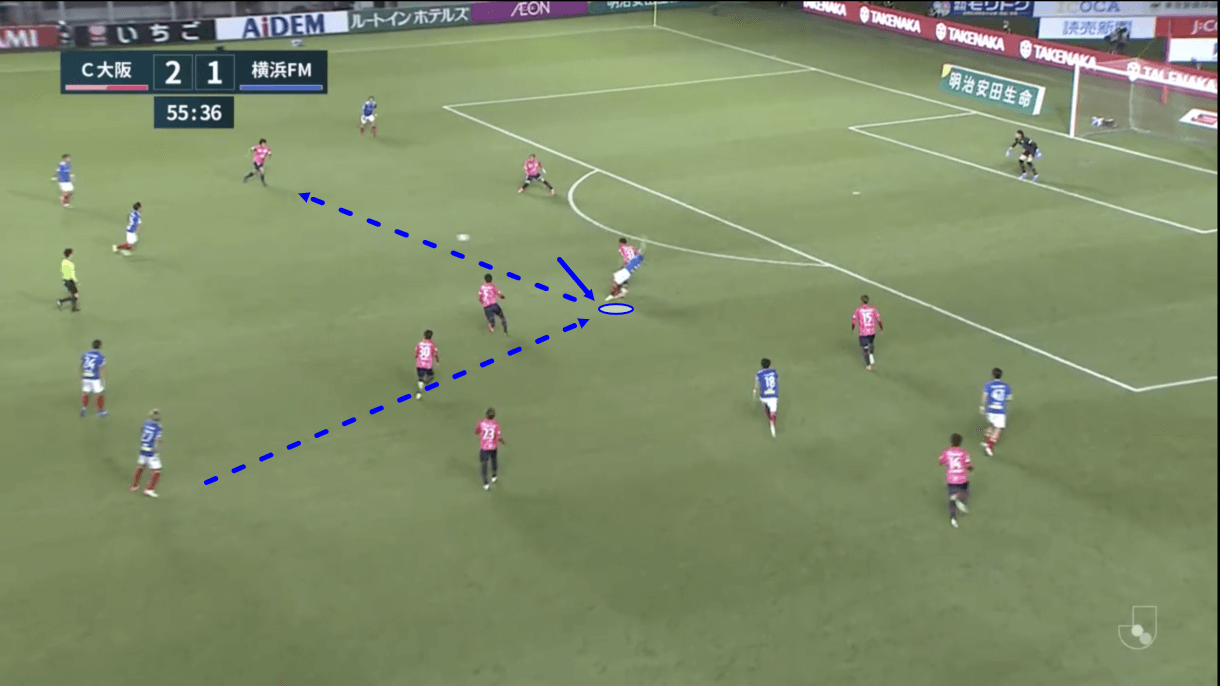
As play moves on into figure 15, we see that this defender remained in Maeda’s path when he received the ball which prevented the attacker from turning, while the pace at which the ball was played and the pace at which he was moving to meet the ball made it more difficult for him to just try and control the ball before making a more calculated decision — Maeda’s general preference for playing quick, one-touch football also plays a part in this, you’ll typically see him opt to play one-touch passes over controlling the ball and slowing the game down, even on occasions where the latter may be a better option.
When the ball arrives at Maeda’s feet here, he tries to pass it to another midfield teammate on the opposite side of the pitch but the fact he was running while receiving the pass set him up to execute the pass poorly, which is what happened. As play moves on from here, we see Maeda’s attempted pass fly into an opposition player’s feet, resulting in this Marinos attack breaking down and highlighting the negative of Maeda’s game when playing with his back to goal. He’s constantly moving while receiving which helps him when receiving through passes or crosses that just require a one-touch finish, but doesn’t work so well in a situation like this one where better composure, decision-making and accuracy are needed.
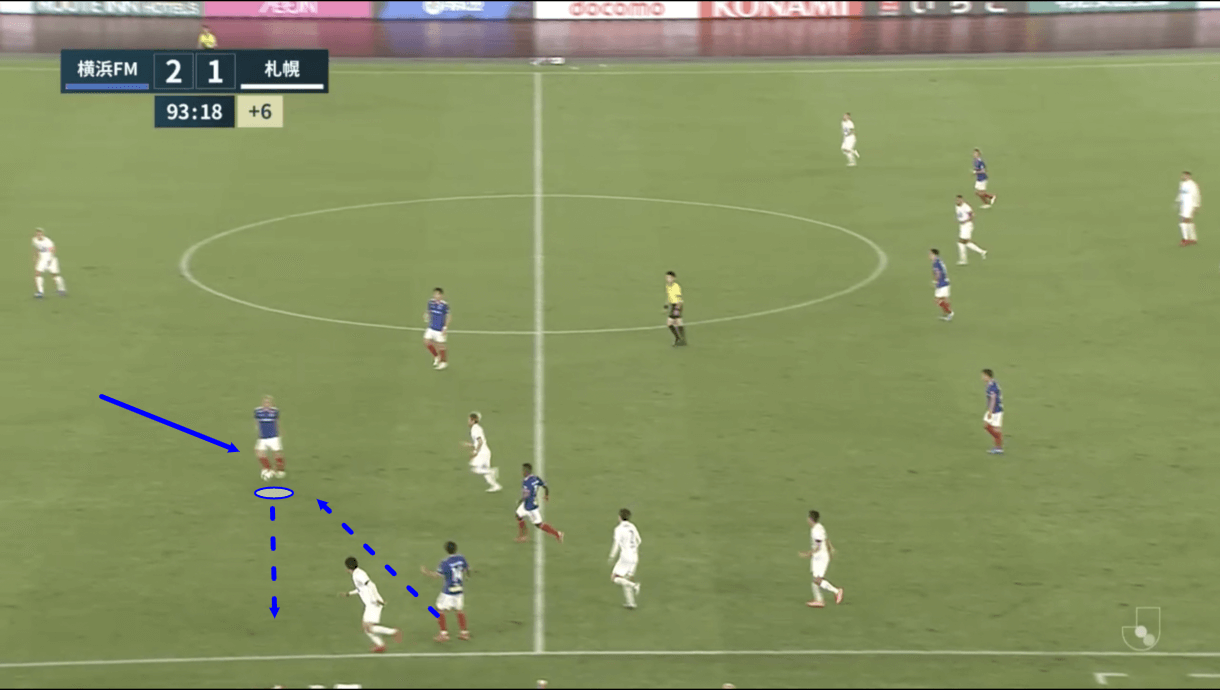
Figure 16 shows another example of Maeda’s tendency to rush play at times. Here, we see an example of the forward playing deeper than in the previous image but still with his back to goal. This time, he enjoys more space, as he wasn’t followed by a defender when dropping deep. Just before this image, he received the ball in the left half-space. Maeda could turn and run at the opposition backline here but as mentioned previously, this isn’t a prominent part of his game — he’s not a technical, tricky dribbler in that mould.
While the player who passed to Maeda stops after releasing the ball, Maeda’s mind is on getting this player progressing further down the wing and opts to play a quick one-touch pass back into what would be this player’s running path had he continued down the wing. As the player didn’t continue progressing down the wing, however, the ball ultimately ended up going to the opposition’s full-back.
This passage of play highlights how Maeda’s rushed play can be negative. While it can, of course, be good to look to play quick one-touch football, there’s a time and place for slowing the game down, taking an extra touch, assessing your options, and making more informed decisions. Maeda would benefit from working on figuring out when he should and shouldn’t look to play so quickly. Learning to slow the game down on occasion would improve his overall game and make him more of an asset when linking up with teammates in chance creation.
Additionally, Maeda would benefit from trying to scan more before receiving the ball when dropping off as we see here to help him make better-informed decisions based on his teammates’ and the opposition players’ positioning.
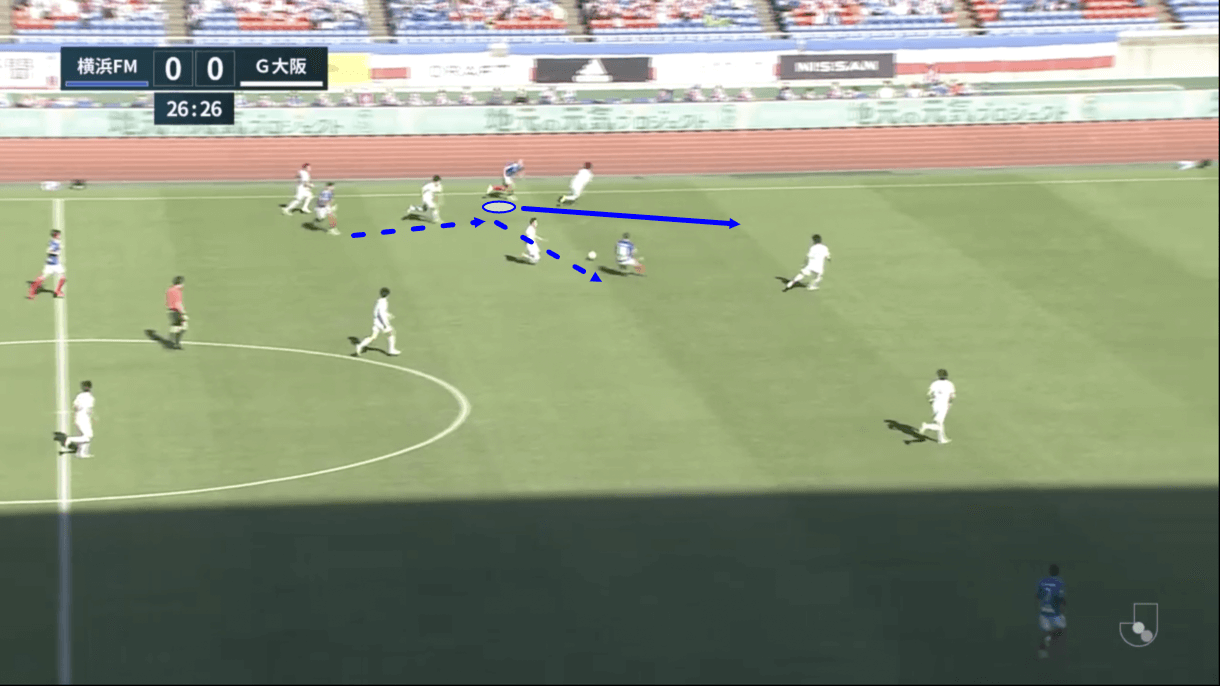
One particular pass that Maeda loves to play is a quick give-and-go. We see an example of this type of pass that the attacker loves in figure 17. Just before this image, Maeda — playing on the left wing — received the ball on the wing facing towards his own goal. Without hesitation, the attacker quickly sent the ball into the centre-forward beside him with one touch before accelerating into the space behind the tight full-back, which the image above shows.
Thanks to his pace and quick acceleration, Maeda is very threatening when attacking this space as he could easily get past the defender with his run and end up behind the opposition’s backline. Maeda’s aim with this pass and quick acceleration is clearly to receive the ball again into the space he’s attacking quickly from the teammate he passed to. This give-and-go is a significant part of the forward’s game in terms of chance creation, as like the dribbling example we analysed previously, it shows how Maeda turns a situation he doesn’t particularly like — receiving the ball with his back to goal — into one that he does like — receiving the ball while running into space. Just like with his dribbling, Maeda’s pace, acceleration and intelligent movement all combine to help him change the style of attack in this manner. Again, this works best when playing against a defender who’s gotten tight to him, as he can quickly turn and accelerate past this player.
This passage of play provides an example of how Maeda’s preference for a quick, one-touch passing game can be beneficial for him and his team. However, the reported Celtic target would benefit from doing a better job of distinguishing between these types of situations and the situation we analysed in figure 16, to decide when he should and shouldn’t look to play such a quick game.
Defensive contribution
Maeda makes an excellent defensive contribution to his team. This season, the pacey Marinos man has made the fifth-most successful defensive actions (7.48 per 90) of any J1 League attacker. He engages in a high number of defensive duels (5.97 per 90), has a high defensive duel success rate (66.09%), and makes a high number of interceptions (3.29 per 90) relative to other attackers in Japan’s top-flight.
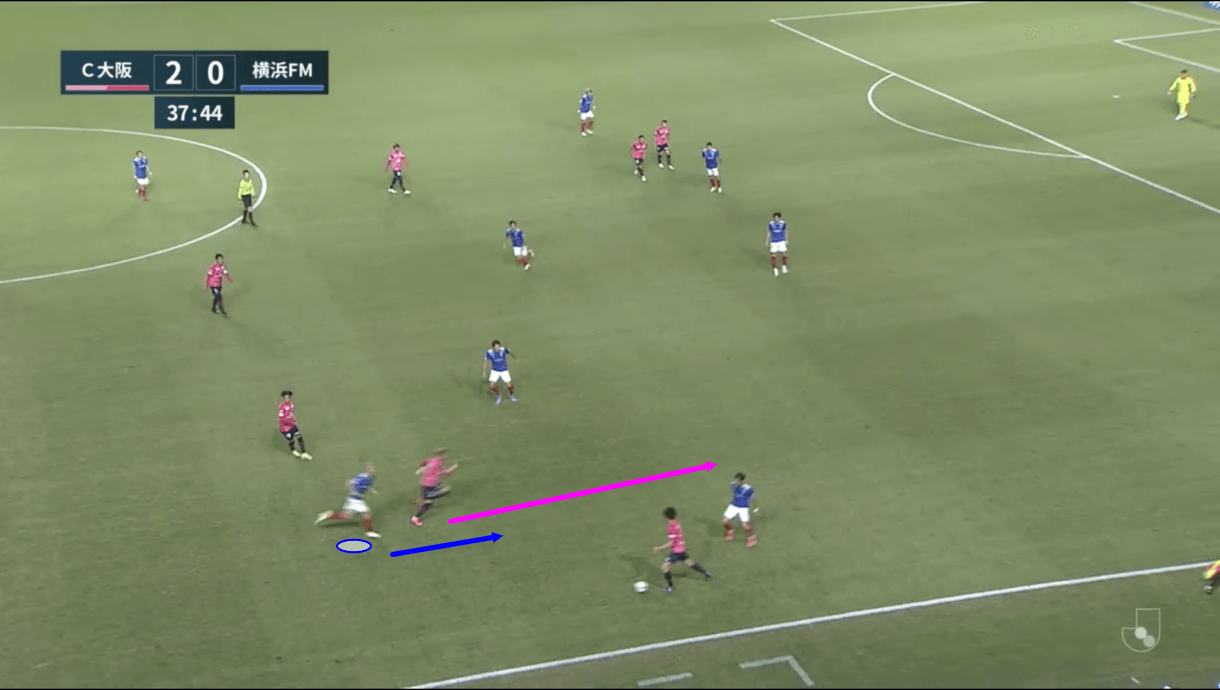
Firstly, Maeda’s diligence in tracking back helps to make him a great asset for his side in later defensive phases. Many of his interceptions come as a result of diligent tracking back. When combined with his pace, this can help him to catch opposition attackers off guard and nip in to win the ball back for his side in deeper positions. In figure 18, we see an example of Maeda diligently tracking his man with the opposition in possession of the ball and Maeda marking a player who’s in the process of storming upfield to provide a progressive passing option for his teammates.
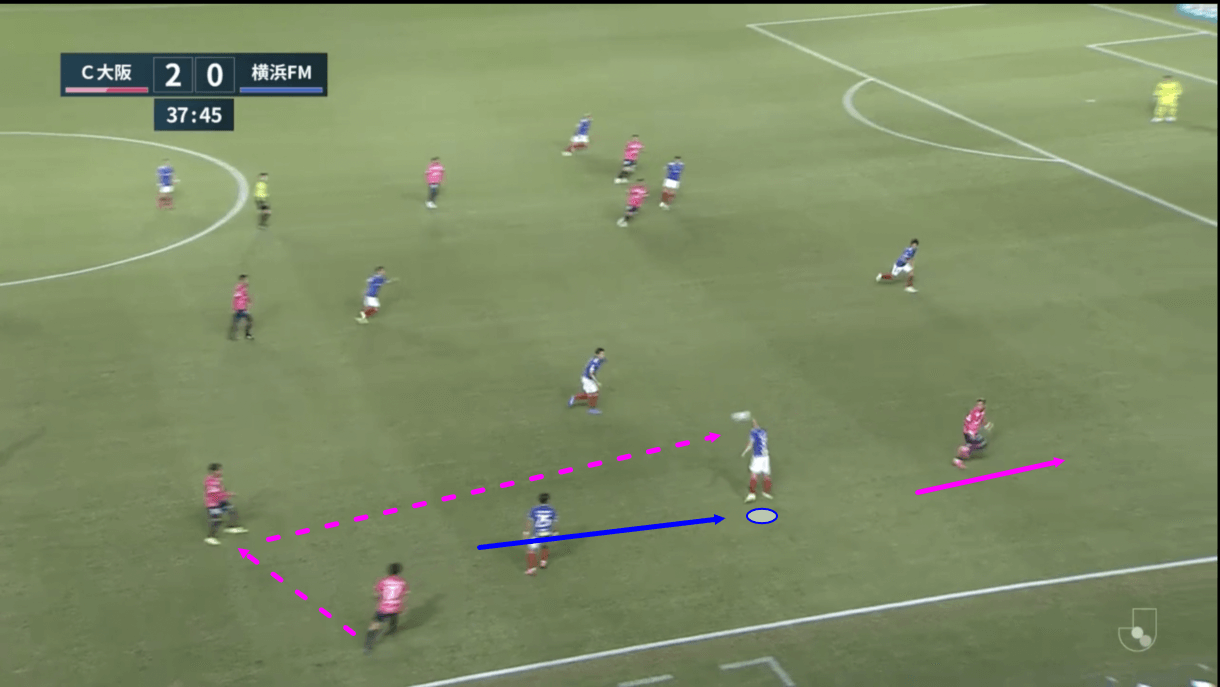
As play moves on into figure 19, the ball has moved from the wing to the centre and as the opposition’s central midfielder received possession, he quickly got his head up, spotted the run from Maeda’s man, and tried to play him through via a lofted pass. However, thanks largely to his diligent tracking back, Maeda is positioned perfectly to prevent the runner from receiving this pass by intercepting the ball.
This passage of play provides an example of how Maeda’s diligent defensive work contributes to his impressive defensive numbers and helps his team in later defensive phases when the opposition are at a more advanced stage of their attack. This can then help Marinos to enjoy counter-attacking opportunities and Maeda’s strengths in possession make him a great counter-attack threat, so this balances out nicely.
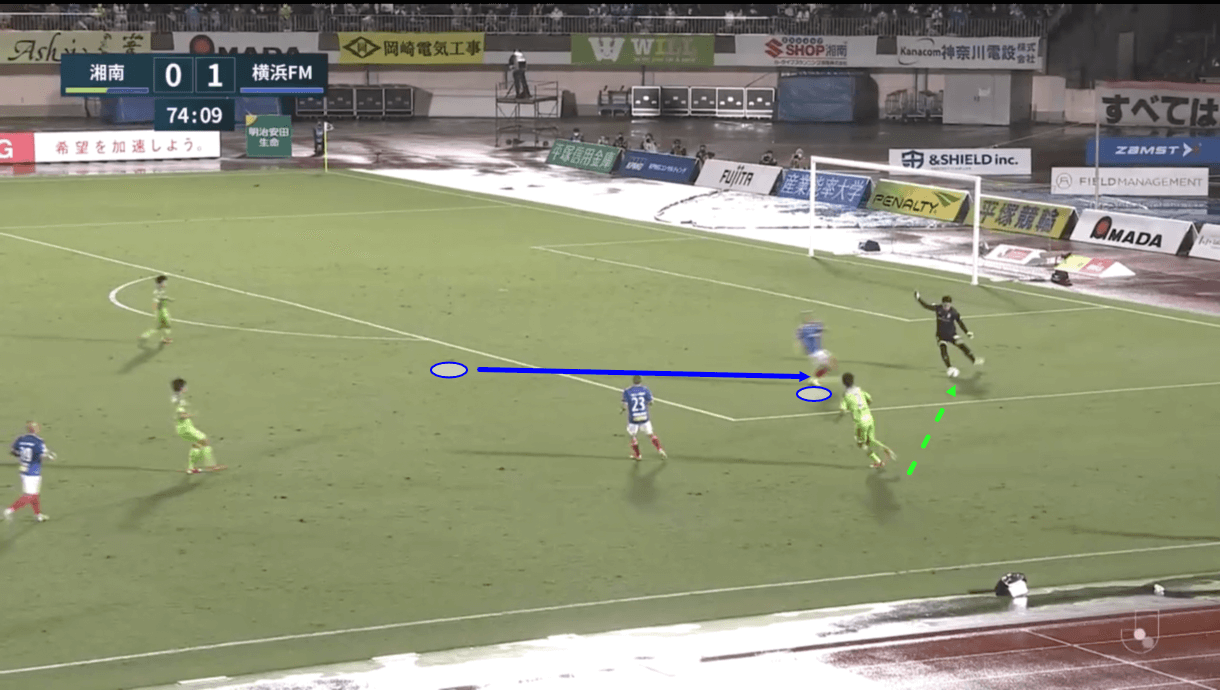
Just like when in possession, Maeda’s pace, acceleration and agility all play important roles in his defensive game too. His agility can help him when the opposition are playing intricate short passes amongst one another as he can quickly change direction at pace to keep pressure on players even after quick short passes are played. Meanwhile, figure 20 provides an example of how Maeda’s pace and acceleration contribute a lot for his side in the high-block — a phase in which the 24-year-old thrives.
Immediately before this image, the opposition’s left-back was on the ball. However, Marinos cut off all the player’s forward passing options via their organisation and pressure, with Maeda playing a key role in that by cutting off the passing lane between this player and the centre-back seen in the image. As a result, the left-back was forced to play the ball back to his goalkeeper.
This backwards pass was the trigger for Maeda to accelerate and as play moved on into figure 20, we saw another excellent example of Maeda’s rapid acceleration as he quickly covered ground while closing down the goalkeeper to get into this position where he’s threatening to dispossess the ‘keeper.
It’s worth noting too that Maeda intelligently keeps the opposition’s centre-back in his cover shadow while pressing the ‘keeper to ensure that the easy passing lane into the centre-back doesn’t open up as a result of his decision to press. This is a demonstration of good awareness from the attacker.
As play moves on from here, the opposition’s goalkeeper is forced into a heavy touch to keep the ball away from the rapidly approaching Maeda and that heavy touch ultimately results in a turnover, so it’s clear how Maeda’s aggressive pressing and rapid acceleration helped his side to force a high turnover in a very dangerous position here, setting up a great attacking opportunity.
Conclusion
To conclude this tactical analysis and scout report, I feel Maeda’s greatest strengths lie in his off-the-ball attacking movement, his two-footedness, the physical assets of pace, acceleration and agility, and impressive defensive diligence. Maeda is a great asset for his side when providing depth in possession, poaching inside the box, and in all defensive phases.
However, Maeda could improve his ability on the ball. He sometimes rushes his play and could benefit from slowing the game down on occasion, while he can also improve his technique when receiving short passes, dribbling, and linking up with teammates. Overall, if a team sets up to allow Maeda to play a role that highlights his strengths, as Marinos have this season, he can be a great overall asset despite his limitations.





Comments